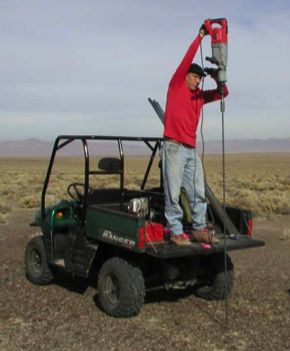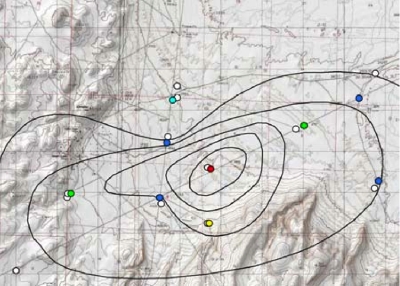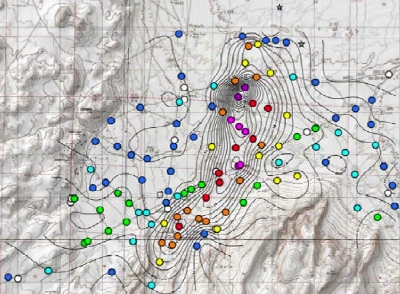Archive for January, 2007
Speaking of big ideas…
The Oil Drum published this long and detailed entry from the Engineer Poet on how to replace our dependence on fossil fuel and get to carbon neutrality using an enhanced biomass system coupled with electricity generation, fuel cells, and battery transport power. If you don’t have time for a long read, are data averse, or have attention deficit, the referenced post might not be for you…
This is an old post by net standards, published at the end of November of last year, but certainly is filled with interesting data. Now I don’t subscribe to the “solve the energy crisis in one fell swoop” approach, but this post did make me think that perhaps more is possible in big hunks than I’ve been allowing. Even so, this is is a grandiose proposal that would require 20 years or more to implement, if it even could be implemented. But the ideas are worth exploring as realizing even 10% of the benefit would make a difference.
The thesis of the post is: “The US can replace our fossil fuel dependence with sustainable fuel and positively impact our carbon footprint – but, not with our current approach, assumptions, or reward system.” The author then goes on to outline at length why our current situation and approach is flawed, current consumption and conversion of energy to work, outlines an improvement using biomass with several outputs including charcoal, ethanol, and electricity, tackles the issue of carbon capture from the atmosphere, then outlines plans for electricity and transportation, and finally ties it all together.
If you’re at all interested in this subject area, this is must-read content. Thanks to Bruce for passing this along.
If you liked this entry, Digg It!
Technorati Tags: Biomass | Carbon Capture | Comprehensive Plan
Enormous Geothermal Canal Proposed
Well here is a bold and interesting idea: Dig a long canal >128km (>80 miles) about 15 meters in diameter (~50 feet) at a depth of >5km (>3 miles) from the ocean on the Atlantic coast inland. Why? Because temperatures exceed 150C (~300F) at that depth, there is no shortage of ocean water, and the transfer of heat to that water over such a long distance would be sufficient to power a geothermal “Hoover Dam” equivalent on the eastern seaboard.
Clearly a project of this magnitude is neither easy nor cheap, but J. David Reynolds at Atlantic Geothermal is championing just such an approach. Aside from the obvious practical challenges of such a project, there are some other things like the amount of total dissolved solids in the water that would definitely need to be addressed. For instance, in the Salton Sea geothermal area in California, one must use titanium lined pipes to withstand the corrosive nature of the geothermal resource. That’s not cheap.
Nevertheless, this is a bold idea who’s feasibility will be debated hotly, no doubt. Regardless of your position on feasibility, it’s nice to see someone thinking big and sustainable.
If you liked this entry, Digg It!
Technorati Tags: Large Scale Geothermal | Northeast | Atlantic Geothermal
Neat solar experiment
In this AP article it’s explained that a State Senator from Virginia is staying in solar-powered home designed by Virginia Tech engineering students. Frank Wagner is using this as a means to raise awareness of renewable energy and self-sufficiency by living in the house outside the Science Museum of Virginia. While the experience hasn’t been bug-free – during a 20F night the water supply froze – it has proven viable. This is a custom 800 square foot dwelling that is more of a prototype than anything else, but it’s great to see Wagner and the students make a public point on the subject.
Congrats to the folks out in Virginia for doing this, it’s a worthwhile exercise.
If you liked this entry, Digg It!
Technorati Tags: Solar House | Frank Wagner | Virginia
Ecologically sound network hosting
A former Sun colleague, Jon Greaves, sent me this article a few days ago:
Norfolk Wildlife Trust now has an environmentally friendly
website, after a move this week to solar powered hosting.
Athenaeum who run EcologicalHosting.com are the only UK
based company to have an entire hosting infrastructure
powered from renewable energy sources, making it
low-impact on the environment.Their main hosting is housed in a data centre in California.
Electricity from 120 solar panels capable of generating up
to 60 kilowatts of electricity per day provides all the power
for data centre offices, air conditioners and all computer
equipment.By choosing to host their website with them, NWT is making
a commitment to the environment to protect the future.
Normal data centres obtain their main power from the local
grid supply, using up very large amounts of electricity that
has been generated from non-renewable sources such as coal,
gas or nuclear power stations. Solar hosting plays its part to
help prevent global warming, and so helps to preserve the
natural habitat of animals around the world.Director of Athenaeum Jamie Simpson commented:
‘EcologicalHosting.com welcomes Norfolk Wildlife Trust to
our solar powered Internet service. Along with our other
clients they are showing the world that they care about the
environment and also making a statement that many
traditionally power hungry services like web hosting do
have viable environmentally friendly alternatives available.’Director of Norfolk Wildlife Trust Brendan Joyce commented:
‘We are delighted to move our website to
EcologicalHosting.com, as it is another way of reducing
our impact on the environment. Our website has plenty
of information on wildlife and caring for the environment,
and now our website hosting matches our green philosophy.”
I found this fascinating and believe we’ll see more of this type of company. Power consumption is one of the largest expenses for hosting providers and when they can tap into renewables where the fuel is free, there’s a real competitive advantage to be had over the long haul. Another opportunity I see clearly is harvesting the tens of millions of btus that are exhausted from data centers. It’s not yet clear what the 20-25C resource is good for, but the person or persons who crack that nut will be very rich…
If you liked this entry, Digg It!
Technorati Tags: Eco Hosting | Renewable Energy | Solar
Finding geothermal resources
If you wondered why there weren’t more geothermal projects, you’re not alone. One of the more vexing things about geothermal resources is finding them. When compared with other renewable resources it’s a much more challenging endeavour. After all, it’s pretty evident how to determine if a site is appropriate for wind or solar generation by monitoring the wind speed and sunlight in potential site areas. While there is definitely science involved, a layperson can do a pretty good job in suggesting sites.
Geothermal, not so much. There are some obvious signs that a geothermal system is at work, these include volcanos, faults, geysers, hotsprings, fumaroles, travertine deposits, and tufa towers. But none of these indications necessarily mean that an area is productive, just clues that they might be productive. So, how does one “discover” and then qualify a geothermal resource?
The answer is that aside from obvious vulcanism and spewing hot water on the surface, to date, most areas are discovered as an unwanted side effect of another activity, like mining or drilling for petroleum. In other words, geothermal finds tend to be the result of serendipidous accidents or stunningly obvious features observed on the surface. The majority of geothermal resources however are called “blind” resources – that is, there is little if any indication on the surface of the earth that a particular spot might house a geothermal resource. Which begs the question: how does one go about specifically looking for geothermal resources and then qualifying them? Particularly “blind” resources (as most of the obvious surface indicated resources have been tapped or protected – like Yellowstone Park’s geysers.)
At the Stanford Geothermal conference yesterday, there were several approaches to find “blind” geothermal resources presented. Most of these have been around for awhile that are increasingly useful in indicating where one might choose to invest serious money to drill a test well. For those who aren’t familiar with the drilling industry, these holes cost a few million dollars to drill. Thus, you want to be pretty sure you’re in an area that will produce before breaking ground.
Of the approaches including thermal imaging, gravity measurements, magnetic resonance, electrical resistance, and shallow temperature prospecting, the shallow temperature approach seems to be the best tool from my perspective. Effectively, this is a method of drilling 2 meter holes in a grid, measuring the temperature at depth, and factoring the surface trends to get a data set. Mark Coolbaugh presented this talk yesterday of a test he performed in the Desert Peak area in Nevada. The results were impressive and interesting as this is a known geothermal production area – even potentially uncovering further resource in the Desert Queen area.
The way it works is dead simple. A grid is laid out over an interesting area, at periodic intervals (every x meters for instance) a 2 meter deep hole is created with a special, hollow steel drill bit attached to an electric hammer drill. It takes a few minutes to drive this into the ground. Once secured, a temperature probe is dropped down the center of the bit and after an hour passes or so, the temperature is taken. The hour was derived by testing to see how quickly a hole returned to base temp state after digging. Instead of having a few measurements available over a large area with huge costs – even 60M “slim holes” for temperature gradient are expensive – one gets a large number of measurements over the same area.
Driving bit into the ground

Desert Queen – 9 Temperature Gradient Wells with 2m temps overlayed. Note, the whites are the temperature gradient wells, the blues are “cold” and the yellows, oranges, and reds are “hot.” As you can see, there is an assumption made about the resource size and shape with the contour lines.

Desert Queen – All 2m data points (and temperature gradient wells.) As you can see, the 9 data point model badly misconstrued the size and shape of the potential resource. The contour lines are 1 degree C differences and at 2m the delta T between “background” and “hot” was greater than 20 degrees C.

This particular approach does have limitations in that shallow aquifers or wet ground will impede the accuracy of the method, but considering the vast majority of geothermically active area in the US is located in arid climates, this isn’t such a barrier to use. Of course, the most effective way (and only way) to truly qualify a resource is through drilling and flow testing of the geothermal resource. At present, drill rig rental runs around $22,500 per DAY – without the crew and that’s if you can even find a rig to rent. It’s an expensive undertaking to be sure. But a simple, relatively cheap, and relatively fast way to profile a large area is using this shallow temperature approach. It seems to work and should be a valuable tool in the geothermal prospector’s portfolio.
The summary is that there are many methods to find “blind” resource and we’re constantly getting better at it. Another question is, who is actually looking for such resources? The only answer I can provide at present is virtually no one.
If you liked this entry, Digg It!
Technorati Tags: Discovery | Blind | Geothermal








